1990 VOLKSWAGEN TRANSPORTER clutch
[x] Cancel search: clutchPage 30 of 165
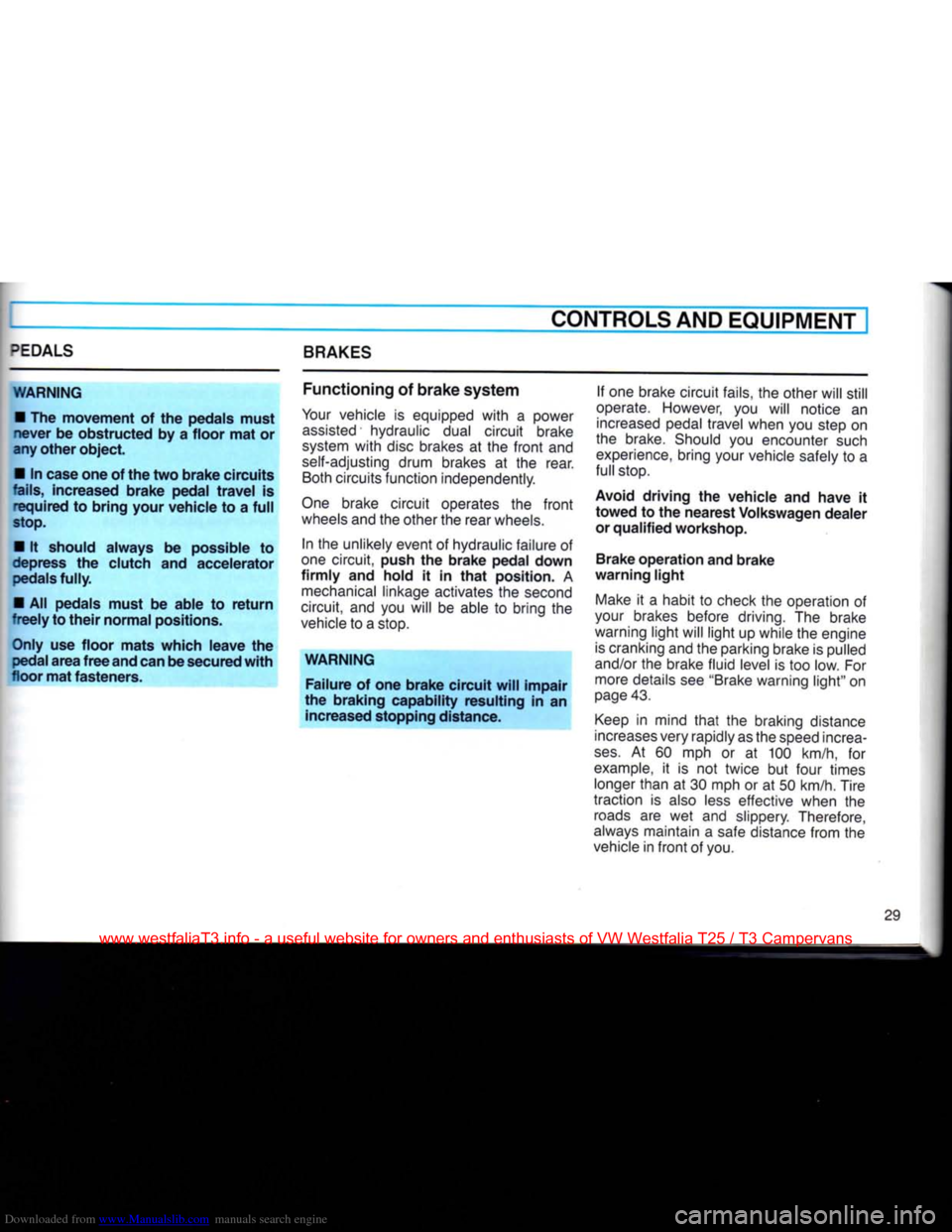
Downloaded from www.Manualslib.com manuals search engine
^EDALS
BRAKES CONTROLS AND EQUIPMENT
WARNING • The movement of the pedals must
never be obstructed by a floor mat or
any other object.
• In case one of the two brake circuits
fails,
increased brake pedal travel is required to bring your vehicle to a full
stop.
• It should always be possible to
depress the clutch and accelerator pedals fully.
• All pedals must be able to return
freely to their normal positions.
Only use floor mats which leave the pedal area free and can be secured with
floor mat fasteners. Functioning of brake system
Your vehicle is equipped with a power assisted hydraulic dual circuit brake
system with disc brakes at the front and
self-adjusting drum brakes at the rear. Both circuits function independently.
One brake circuit operates the front
wheels and the other the rear wheels. In the unlikely event of hydraulic failure of
one circuit, push the brake pedal down
firmly and hold it in that position. A mechanical linkage activates the second
circuit, and you will be able to bring the
vehicle to a stop.
WARNING Failure of one brake circuit will impair
the braking capability resulting in an increased stopping distance. If one brake circuit fails, the other will still
operate. However, you will notice an increased pedal travel when you step on
the brake. Should you encounter such experience, bring your vehicle safely to a
full stop.
Avoid driving the vehicle and have it
towed to the nearest Volkswagen dealer or qualified workshop.
Brake operation and brake
warning light
Make it a habit to check the operation of
your brakes before driving. The brake
warning light will light up while the engine is cranking and the parking brake is pulled
and/or the brake fluid level is too low. For more details see "Brake warning light" on
page 43.
Keep in mind that the braking distance
increases very rapidly as the speed increa
ses.
At 60 mph or at 100 km/h, for example, it is not twice but four times longer than at 30 mph or at 50 km/h. Tire
traction is also less effective when the roads are wet and slippery. Therefore,
always maintain a safe distance from the
vehicle in front of you.
29
www.westfaliaT3.info - a useful website for owners and enthusiasts of VW Westfalia T25 / T3 Campervans
Page 33 of 165
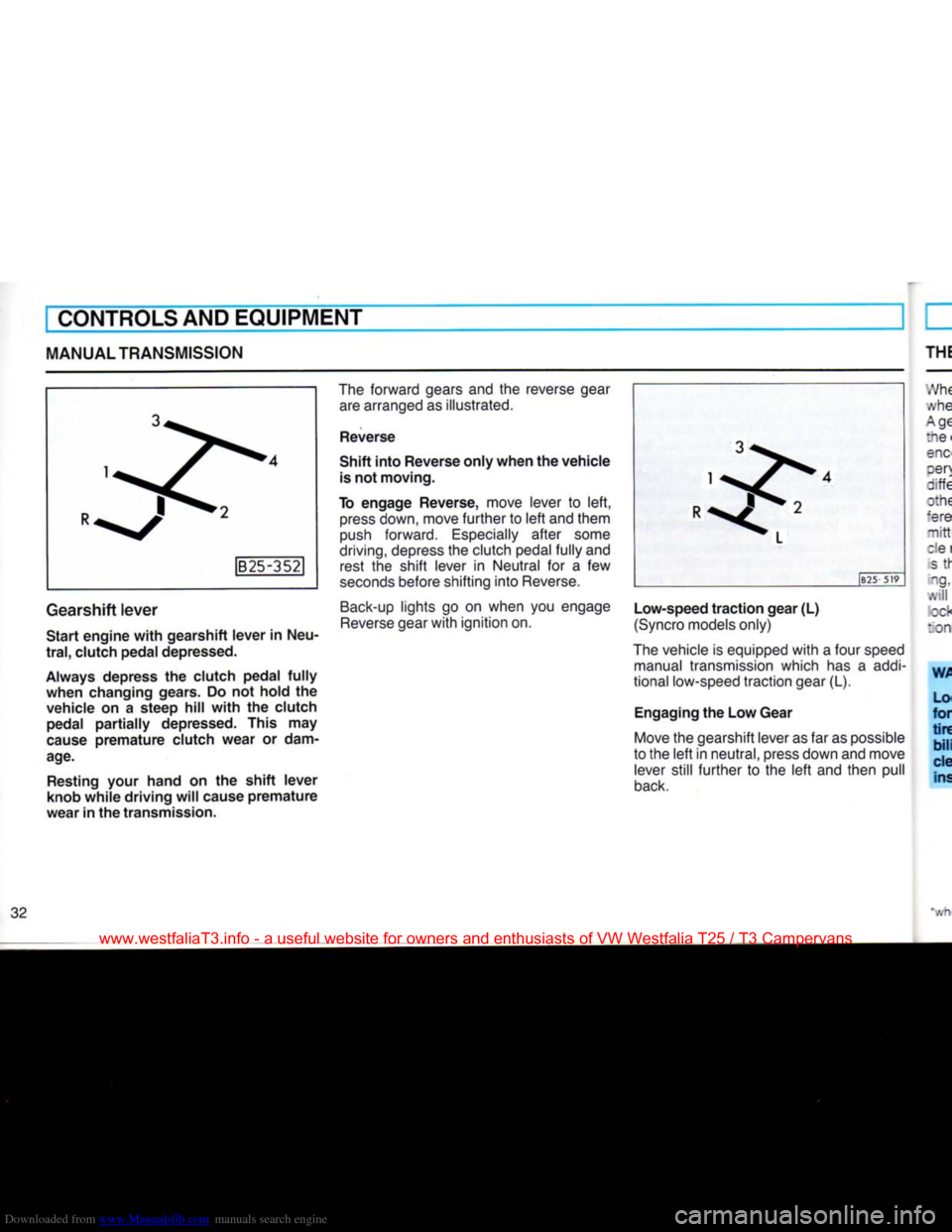
Downloaded from www.Manualslib.com manuals search engine
CONTROLS AND EQUIPMENT
MANUAL TRANSMISSION
B25-352
Gearshift lever
Start engine with gearshift lever in Neu
tral,
clutch pedal depressed.
Always depress the clutch pedal fully
when changing gears. Do not hold the vehicle on a steep hill with the clutch pedal partially depressed. This may
cause premature clutch wear or dam
age.
Resting your hand on the shift lever
knob while driving will cause premature
wear in the transmission. The forward gears and the reverse gear
are arranged as illustrated.
Reverse
Shift into Reverse only when the vehicle is not moving.
To engage Reverse, move lever to left, press down, move further to left and them
push forward. Especially after some
driving,
depress the clutch pedal fully and rest the shift lever in Neutral for a few
seconds before shifting into Reverse.
Back-up lights go on when you engage Reverse gear with ignition on. JB25-519
Low-speed traction gear (L)
(Syncro models only)
The vehicle is equipped with a four speed manual transmission which has a
addi
tional low-speed traction gear (L).
Engaging the Low Gear
Move the gearshift lever as far as possible
to the left in neutral, press down and move lever still further to the left and then pull
back.
www.westfaliaT3.info - a useful website for owners and enthusiasts of VW Westfalia T25 / T3 Campervans
Page 37 of 165

Downloaded from www.Manualslib.com manuals search engine
CONTROLS
AND EQUIPMENT
1 - Position for steep hills
This
position is to be
used
for mountain
driving
or
slow
driving.
It
also
provides
for
maximum
engine
braking effect. To
engage this gear depress the push but
ton in the handle of the selector lever
first. In "1" the
transmission
will
stay
in first
gear
and will not upshift.
The road speed must not exceed 33 mph
or
53 km/h. Only shift down into "1"
when the speed is below this speeds.
WARNING
Do
not shift to a lower driving position
until vehicle speed has dropped below
the specified limits otherwise engine
speed
will
suddenly increase and may
cause
engine damage and
loss
of
vehicle control. Driving the automatic transmission
Starting the engine
The
selector
lever
must be in Neutral or Park. If one of the driving
positions
is
engaged
a
safety
switch will prevent the
engine
from
being
started.
Emergency
starting
Your
Volkswagen
with
Automatic
Transmis
sion
cannot
be started by
pushing
or tow
ing.
If
engine
does
not start
because
of
dis
charged
battery, the
vehicle
can be started
with jumper
cables.
Refer
to
"Emergency
starting
with jumper
cables".
Should
the
engine
fail to start
consult
your
nearest
Volkswagen
dealer.
Selecting
a driving position
WARNING
•
Apply the foot brake before select
ing a driving position when the vehicle
is
stationary.
When the selector lever is in a driving
position,
the vehicle may creep even at
idle speed. Therefore, do not release
the parking brake or foot brake until
you
are ready to move, because power
is
transmitted to the wheels as soon as
a driving position is engaged.
•
Do not accelerate
while
selecting
a driving position. At this
time
the en
gine must run at idle speed so
that
no undue stress
will
be placed on the auto
matic clutches in the transmission.
•
Never have any position engaged
when checking in the engine compart ment. Make sure the selector lever is
securely
locked into the P position
with
the parking brake firmly set. Otherwise, any increase in engine speed may set
the vehicle in motion, even
with
the parking brake applied.
www.westfaliaT3.info - a useful website for owners and enthusiasts of VW Westfalia T25 / T3 Campervans
Page 40 of 165

Downloaded from www.Manualslib.com manuals search engine
CONTROLS
AND
EQUIPMENT
STARTING
PROCEDURES
WARNING
•
Fasten safety belts before driving.
•
Never
start or let the engine run in a
confined or enclosed, unventilated
area.
Exhaust fumes from the engine
contain carbon monoxide, which is a
colorless
and odorless gas. Carbon monoxide can be
fatal
if inhaled.
•
Never
leave engine idling unatten
ded.
An unattended vehicle with a run
ning
engine is potentially hazardous.
•
Do not park or operate the vehicle in
areas
where the hot exhaust system may come in contact with dry grass,
brush,
fuel
spill
or other
material,
which can cause a fire.
•
Do not leave engine unattended at
idle.
When starting engine, be ready to
drive off immediately. Maintain moder
ate
speed until the engine is
com
pletely warm. Remember that
your
en
gine performs best at operating
tem
perature.
Automatic
Transmission
Engine will only start with selector lever in
Neutral or Park.
Manual
Transmission
Start with gearshift lever in Neutral, clutch
pedal
depressed, so that the starter only
has
to crank the engine.
Starting
engine
•
Do not depress accelerator pedal
when starting. At extrem low temperatures
the engine will probably start better, if you depress accelerator pedal slighly.
•
As soon as the engine starts, release
the ignition key.
•
If the engine does not start the first time
or
stalls,
turn
the ignition off and restart. Depress the accelerator pedal slowly
during the second starting attempt.
•
Operate the starter for no more than
10
seconds.
•
Allow about 30 seconds between each
starting
attempt.
STOPPING
ENGINE
Do not stop engine immediately after
hard or extended driving. Keep engine
running for about two minutes to pre
vent
excessive heat build-up.
WARNING
•
Before you check anything in the
engine compartment, stop the engine and let it cool down. Hot components
can
burn skin on contact.
•
The radiator fan switches on auto
matically
when the coolant reaches a cer
tain
temperature and will continue to run
(even
with ignition off) until the coolant
temperature drops.
39
www.westfaliaT3.info - a useful website for owners and enthusiasts of VW Westfalia T25 / T3 Campervans
Page 50 of 165
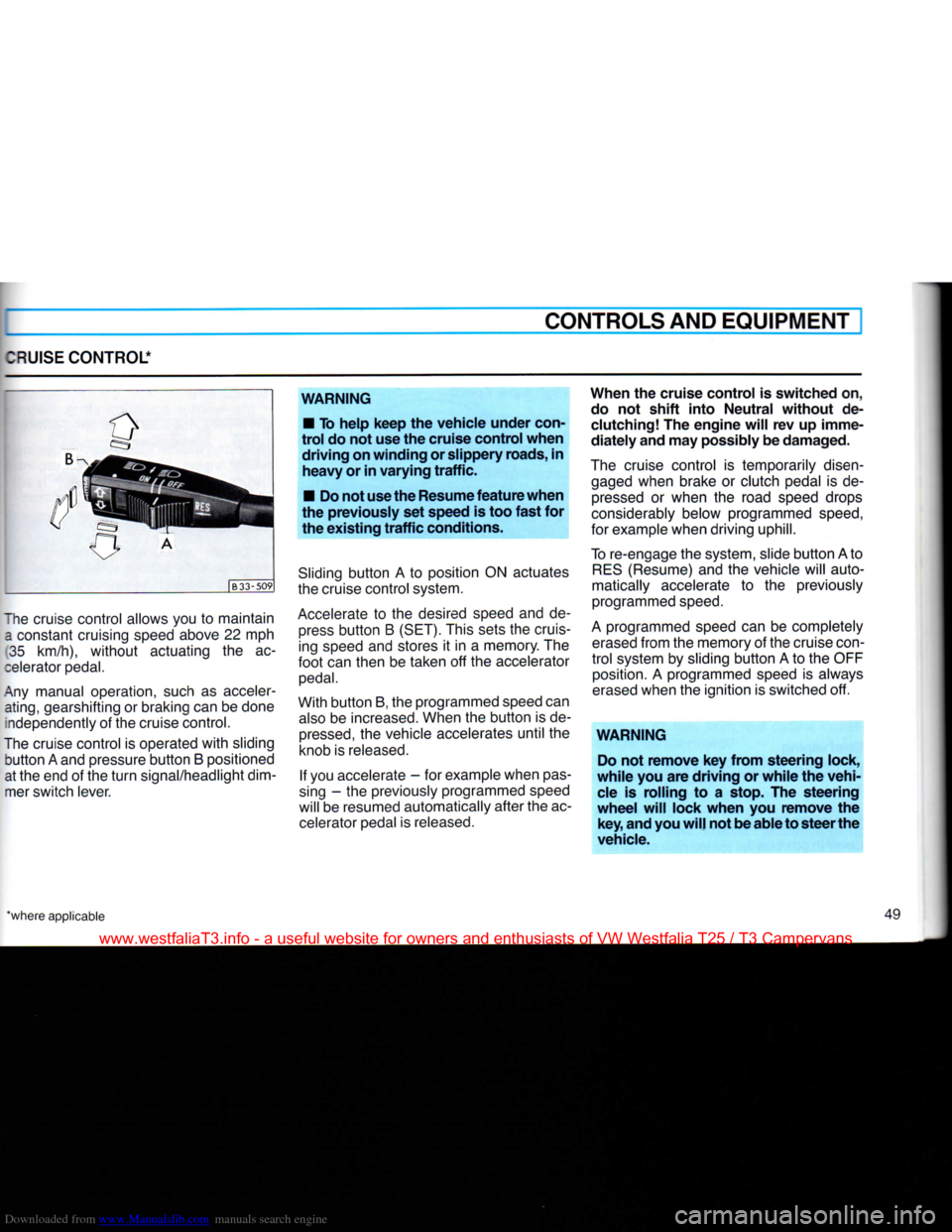
Downloaded from www.Manualslib.com manuals search engine
I
CONTROLS AND
EQUIPMENT
CRUISE
CONTROL*
JB33-509
The cruise control allows you
to
maintain a constant cruising speed above
22 mph
35
km/h),
without
actuating
the ac
celerator pedal.
Any
manual operation, such
as
acceler ating, gearshifting
or
braking can be done independently
of
the cruise control.
The cruise control
is
operated
with
sliding
button
A
and pressure
button
B
positioned
at the end
of
the
turn
signal/headlight dim mer switch lever.
WARNING
•
To help keep the vehicle under
con
trol do not use the cruise control when driving on winding or slippery
roads,
in heavy or in varying traffic.
•
Do not
use
the
Resume
feature when
the previously set speed is too fast for the existing traffic
conditions.
Sliding
button
A to
position
ON
actuates
the cruise control system.
Accelerate
to the
desired speed
and de
press
button
B
(SET).
This sets
the
cruising speed and stores
it in a
memory. The
foot
can then
be
taken
off the
accelerator
pedal.
With
button
B, the programmed speed can
also
be
increased. When
the
button
is
de
pressed,
the
vehicle accelerates
until
the
knob
is
released.
If
you accelerate
- for
example when
pas
sing
- the
previously programmed speed
will
be
resumed automatically after the ac celerator pedal
is
released.
When the cruise control is switched on,
do
not shift into Neutral without de
clutching!
The engine
will
rev up imme
diately and may
possibly
be damaged.
The cruise control
is
temporarily disen gaged when brake
or
clutch pedal
is de
pressed
or
when
the
road speed drops
considerably below programmed
speed,
for example when driving uphill.
To
re-engage the system, slide
button
A to
RES
(Resume) and
the
vehicle will auto
matically accelerate
to the
previously
programmed
speed.
A
programmed speed can
be
completely
erased
from the memory
of
the cruise
con
trol
system
by
sliding
button
A to the
OFF position.
A
programmed speed
is
always
erased
when the ignition
is
switched
off.
WARNING
Do
not remove key from steering lock,
while you are driving or while the vehi
cle
is rolling to a stop. The steering
wheel
will
lock when you remove the key, and
you
will
not be able to steer the
vehicle.
'where applicable 49
www.westfaliaT3.info - a useful website for owners and enthusiasts of VW Westfalia T25 / T3 Campervans
Page 71 of 165
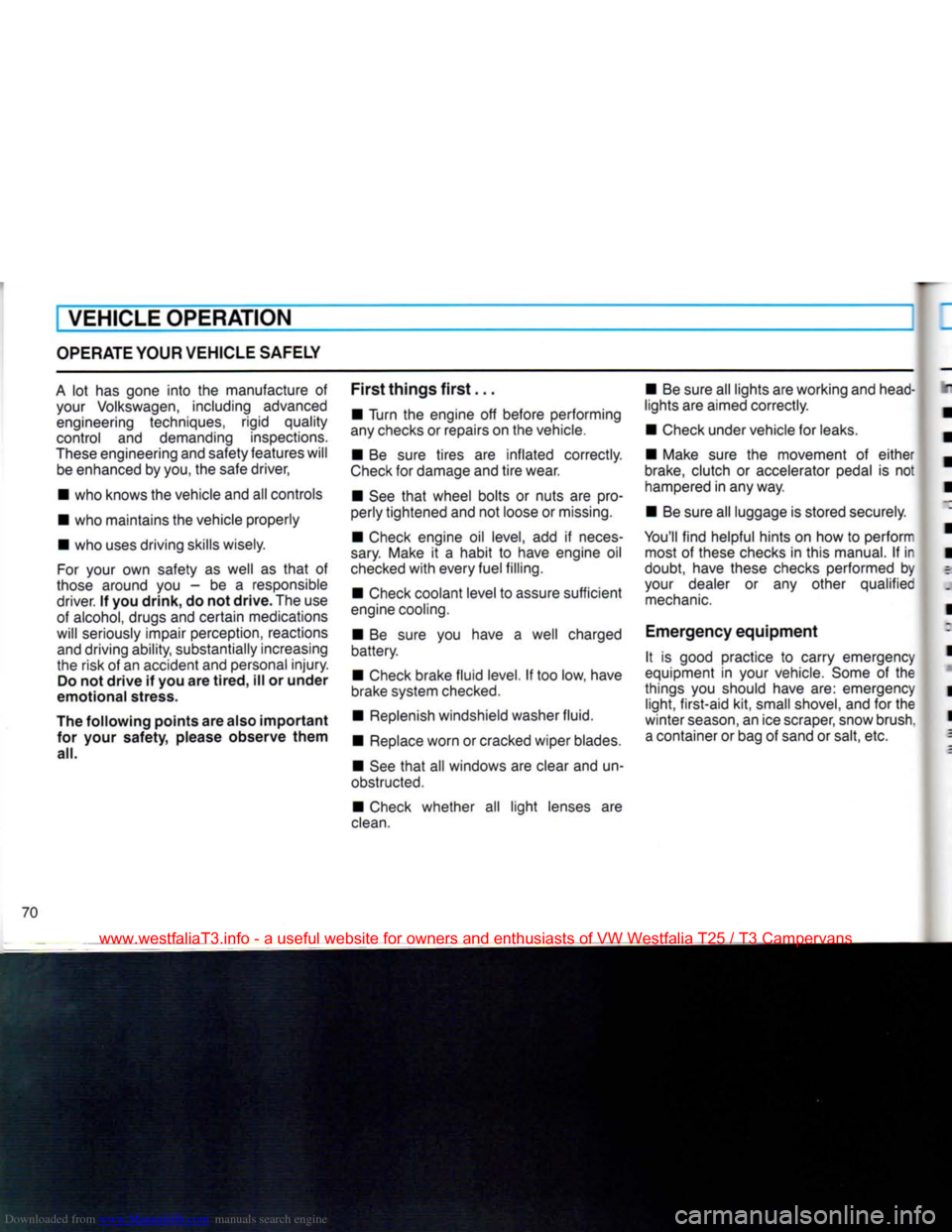
Downloaded from www.Manualslib.com manuals search engine
VEHICLE OPERATION
OPERATE
YOUR VEHICLE SAFELY
A
lot has gone
into
the manufacture of your Volkswagen, including advanced engineering techniques, rigid quality
control and demanding inspections.
These
engineering and safety features will be enhanced by you, the safe driver,
• who knows the vehicle and all controls
• who maintains the vehicle properly
• who uses driving skills wisely.
For
your own safety as well as
that
of
those around you - be a responsible
driver. If you
drink,
do not
drive.
The use
of alcohol, drugs and certain medications
will seriously impair perception, reactions and driving ability, substantially increasing
the risk of an accident and personal
injury.
Do not
drive
if you are
tired,
ill or
under
emotional
stress.
The
following
points
are also
important
for
your
safety,
please
observe
them
all.
First
things
first...
• Turn the engine off before performing
any checks or repairs on the vehicle.
• Be sure tires are inflated correctly.
Check
for damage and
tire
wear.
• See
that
wheel bolts or nuts are pro
perly tightened and not loose or missing.
• Check engine oil level, add if neces
sary.
Make it a habit to have engine oil
checked
with
every fuel filling.
• Check coolant level to assure sufficient
engine cooling.
• Be sure you have a well charged
battery.
• Check brake fluid level. If too low, have
brake system checked.
• Replenish windshield washer fluid.
• Replace worn or cracked wiper blades.
• See
that
all windows are clear and un
obstructed.
• Check whether all
light
lenses are
clean.
• Be sure all lights are working and head
lights are aimed correctly.
• Check under vehicle for leaks.
• Make sure the movement of either
brake,
clutch or accelerator pedal is not hampered in any way.
• Be sure all luggage is stored securely.
You'll
find helpful hints on how to perform most of these checks in this manual. If in
doubt, have these checks performed by
your dealer or any other qualified
mechanic.
Emergency
equipment
It is good practice to carry emergency
equipment in your vehicle. Some of the
things you should have are: emergency
light,
first-aid kit, small shovel, and for the
winter
season,
an ice scraper, snow brush,
a
container or bag of sand or salt, etc.
70
www.westfaliaT3.info - a useful website for owners and enthusiasts of VW Westfalia T25 / T3 Campervans
Page 86 of 165
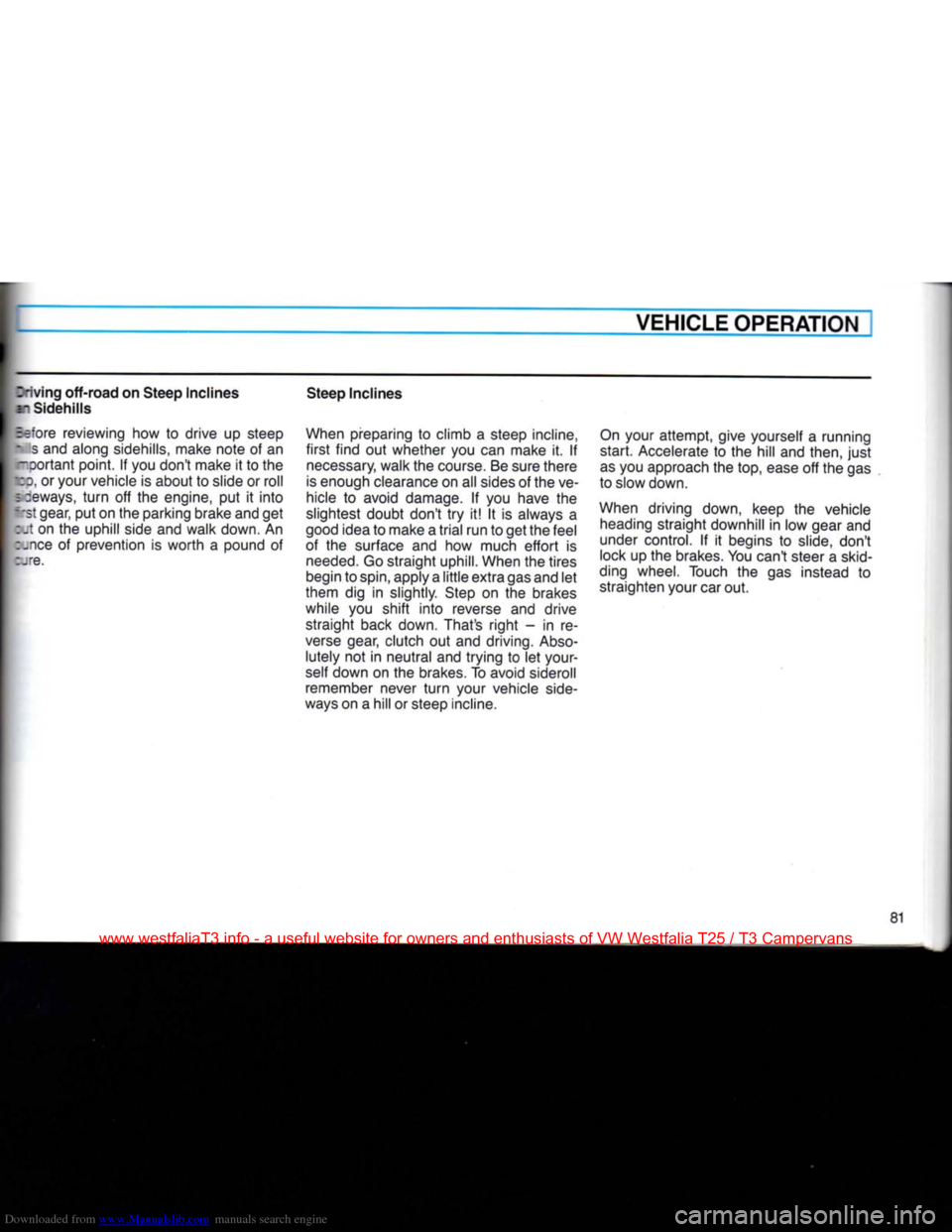
Downloaded from www.Manualslib.com manuals search engine
VEHICLE OPERATION
I'iving
off-road on Steep Inclines
I Sidehills
Before reviewing how to drive up steep
• s and along sidehills, make note of an -oortant point. If you don't make it to the
co.
or your vehicle is about to slide or roll
= :eways,
turn
off the engine, put it
into
I
'3t
gear, put on the parking brake and get
W
on the uphill side and walk down. An
:^nce
of prevention is
worth
a pound of i.re.
Steep
Inclines
When preparing to climb a steep incline,
first
find out whether you can make it. If
necessary,
walk the course. Be sure there
is
enough clearance on all sides of the ve
hicle to avoid damage. If you have the
slightest doubt don't try it! It is always a
good idea to make a
trial
run to get the feel
of the surface and how much
effort
is
needed.
Go straight uphill. When the tires
begin to
spin,
apply a
little
extra gas and let
them dig in slightly. Step on the brakes
while you shift
into
reverse and drive straight back down. That's
right
- in re
verse
gear, clutch out and driving.
Abso
lutely not in neutral and
trying
to let your
self down on the brakes. To avoid sideroll remember never
turn
your vehicle
side
ways on a hill or steep incline.
On
your attempt, give yourself a running
start. Accelerate to the hill and then,
just
as
you approach the top,
ease
off the gas
to slow down.
When driving down, keep the vehicle heading straight downhill in low gear and
under control. If it begins to slide, don't lock up the brakes. You can't steer a
skid
ding wheel. Touch the gas instead to
straighten your car out.
www.westfaliaT3.info - a useful website for owners and enthusiasts of VW Westfalia T25 / T3 Campervans
Page 147 of 165
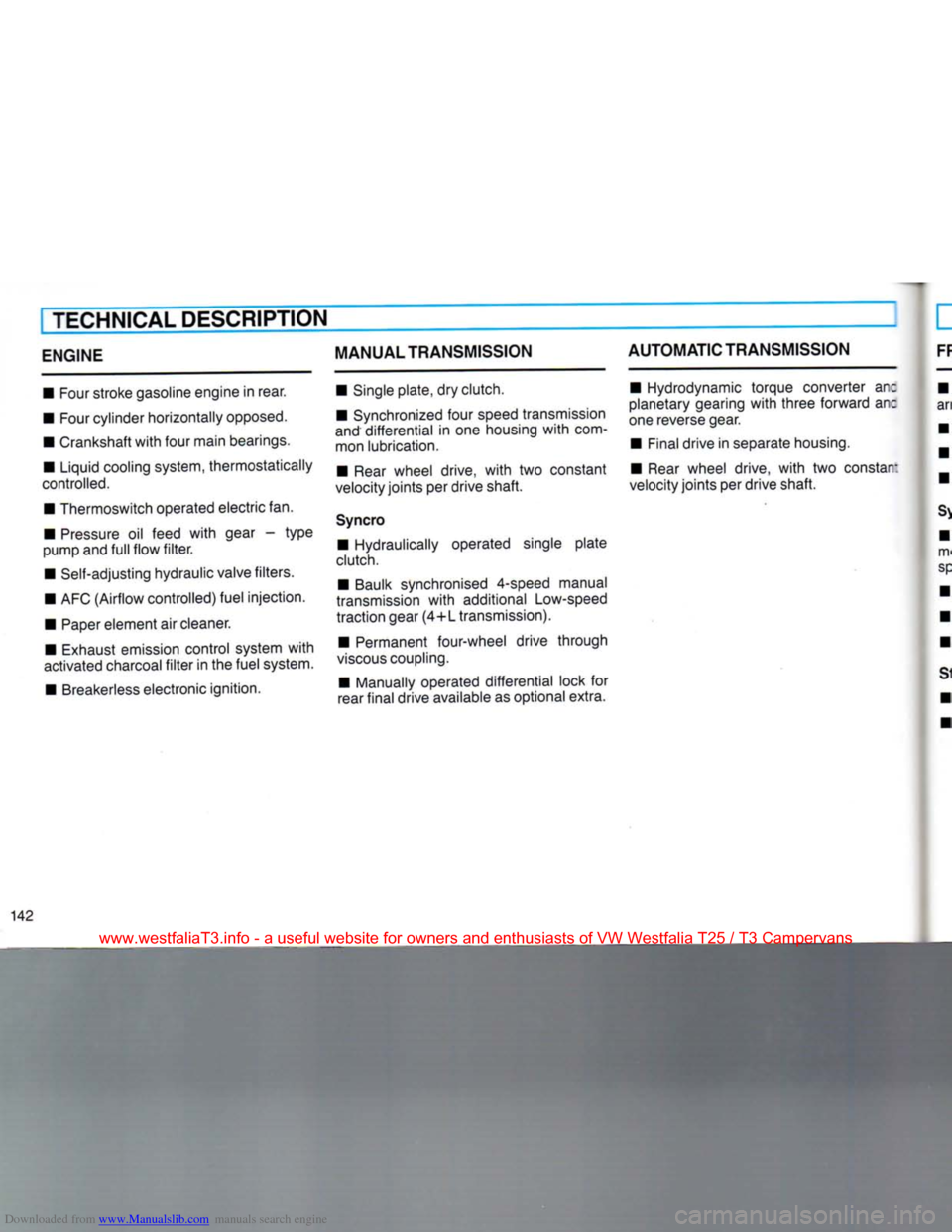
Downloaded from www.Manualslib.com manuals search engine
I TECHNICAL
DESCRIPTION
ENGINE
MANUAL
TRANSMISSION
AUTOMATIC
TRANSMISSION
• Four stroke gasoline engine in rear.
• Four cylinder horizontally opposed.
• Crankshaft
with
four main bearings.
• Liquid cooling system, thermostatically
controlled.
• Thermoswitch operated electric fan. • Pressure oil feed
with
gear - type
pump and
full
flow
filter.
• Self-adjusting hydraulic valve filters.
• AFC (Airflow controlled) fuel injection.
•
Paper
element air cleaner.
• Exhaust emission control system
with
activated charcoal
filter
in the fuel system.
• Breakerless electronic ignition. • Single plate, dry clutch.
• Synchronized four speed transmission
and'
differential in one housing
with
com
mon lubrication.
•
Rear
wheel drive,
with
two constant
velocity joints per drive shaft.
Syncro • Hydraulically operated single plate
clutch.
• Baulk synchronised 4-speed manual
transmission
with
additional Low-speed
traction gear (4+L transmission).
• Permanent four-wheel drive through
viscous
coupling.
• Manually operated differential lock for
rear final drive available as optional extra. • Hydrodynamic torque converter an:
planetary gearing
with
three forward an:
one reverse gear.
• Final drive in separate housing.
•
Rear
wheel drive,
with
two constar:
velocity joints per drive shaft.
www.westfaliaT3.info - a useful website for owners and enthusiasts of VW Westfalia T25 / T3 Campervans